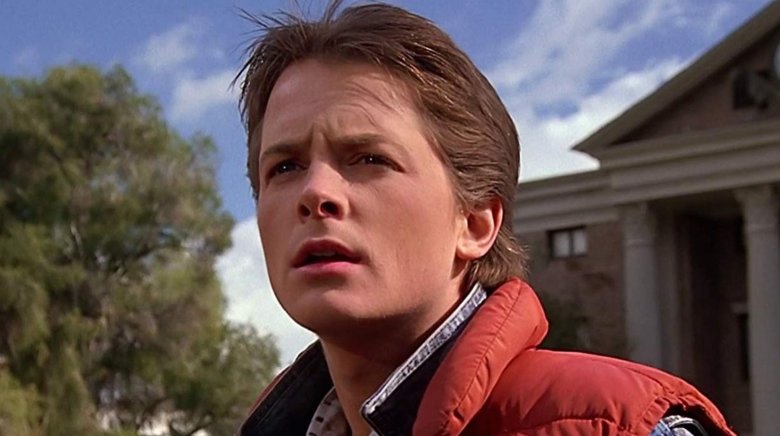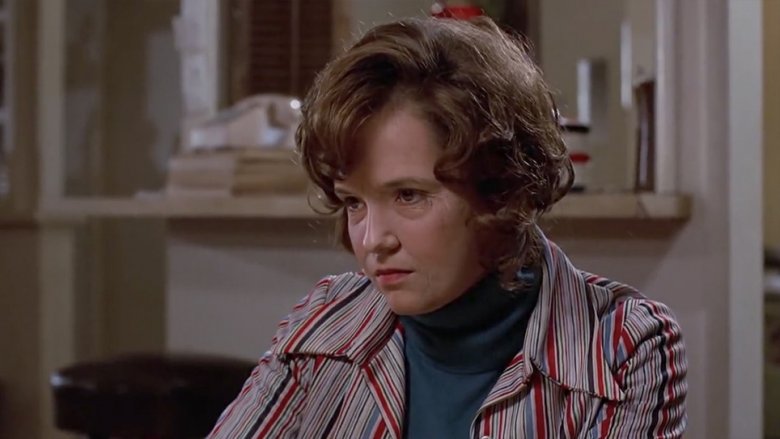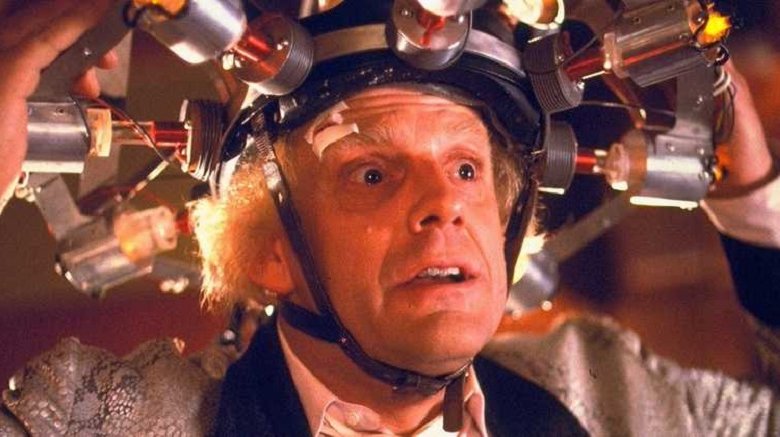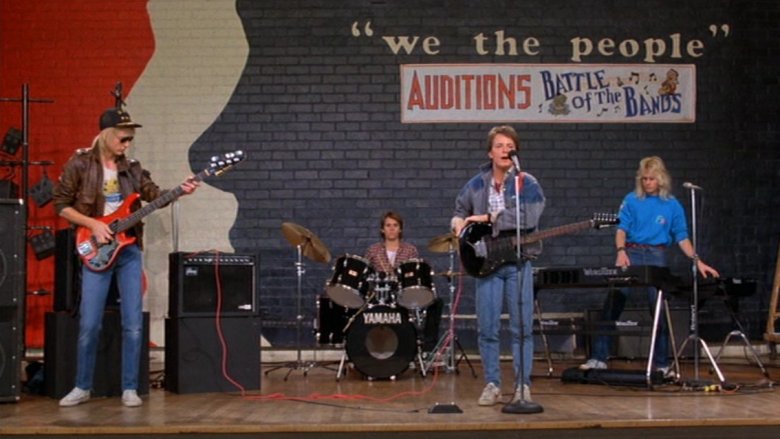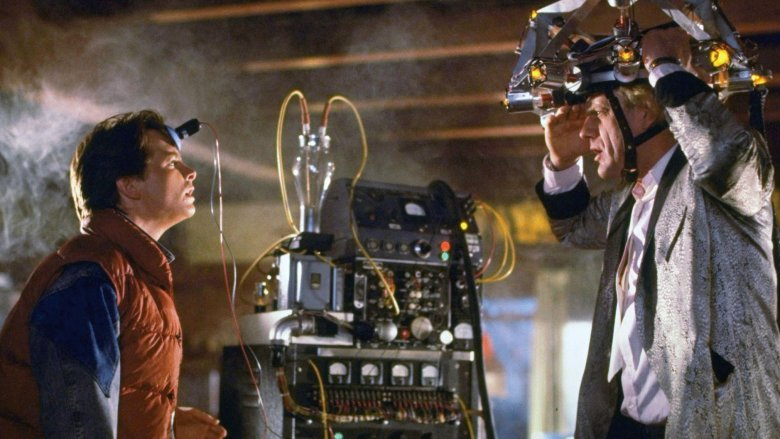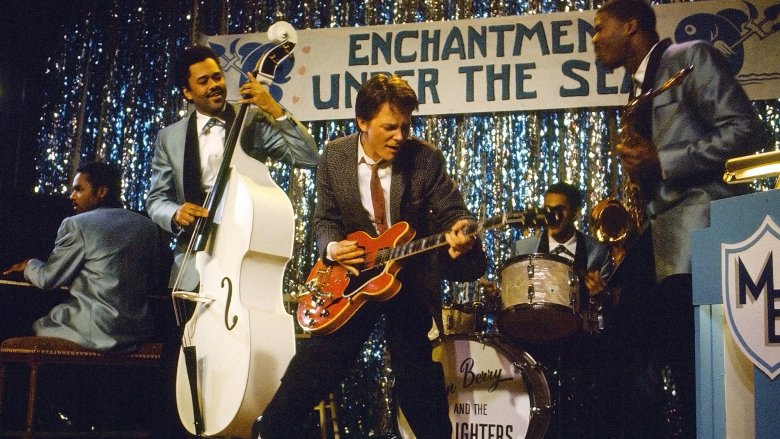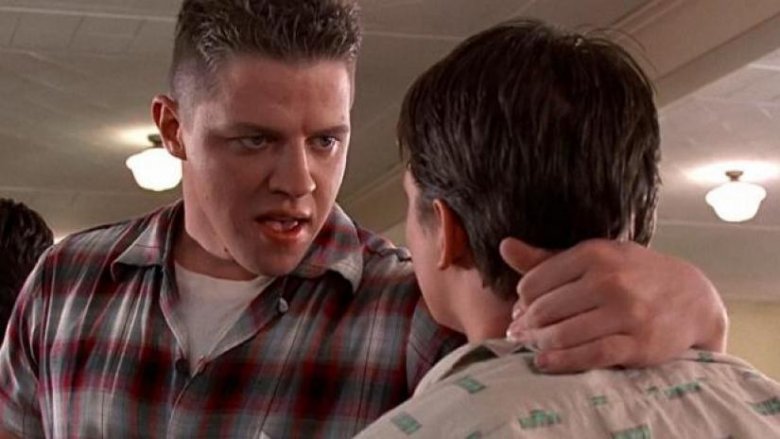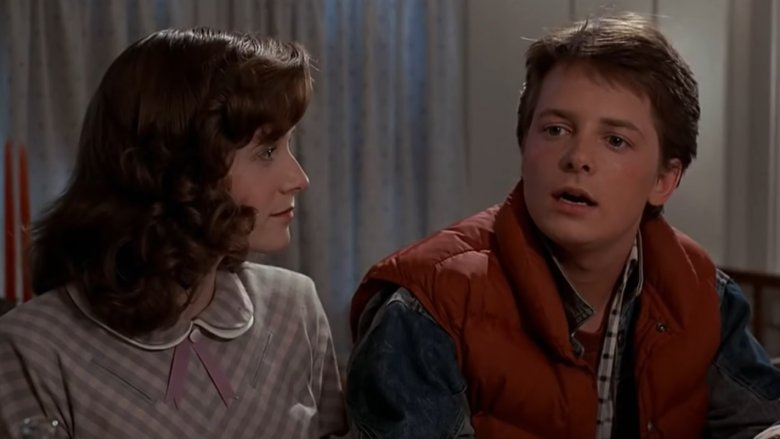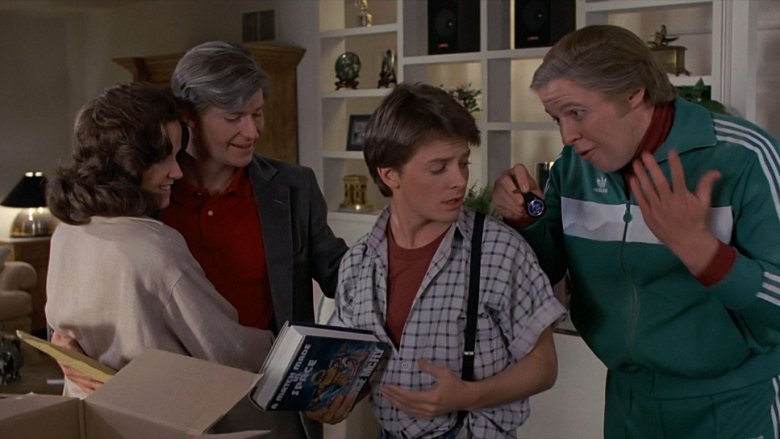Dumb Things In Back To The Future Everyone Ignored
Back to the Future is a stone-cold classic, one of those movies that just about everybody loves. And why wouldn't they? There's a lot to like. For example, it's got an original if mildly scandalous premise — '80s teen Marty McFly (Michael J. Fox) uses a DeLorean-based time machine invented by his friend, Dr. Emmett Brown (Christopher Lloyd), to go back to the '50s to make sure his parents get together ... only to fend off the romantic advances of his own mom. Plus, there's lots of sci-fi action, silly comedy, and Huey Lewis's fist-pumping "The Power of Love."
But this is a time travel movie, so things get a little complicated. Any time characters jump back and forth between timelines and altering events, paradoxes and plot holes are bound to spring up. That, along with some artistic license on the part of the filmmakers, can lead to some plot points (as well as character traits) that are confusing, baffling, and impossible to not see once you've spotted them. So while Back to the Future is a marvelous movie, there are a few things in it that leave viewers scratching their heads, and we're not going to ignore these dumb things anymore.
So much old age makeup in Back to the Future
In order to have the same actors portray both the 1955 and 1985 versions of George McFly, Lorraine Baines McFly, and Biff Tannen, Back to the Future had to employ the use of heavy makeup. Youthful stars Crispin Glover, Lea Thompson, and Thomas F. Wilson appeared in their 1955 scenes relatively unencumbered, and then acted beneath tons of thick makeup and other aging apparatuses for the parts of the movie set in 1985.
Now, that's only a 30-year difference. In 1955, George, Lorraine, and Biff are (roughly) 17-year-old high school students. Some simple math indicates that in 1985, they're all about 47. But the makeup department was extremely liberal with the aging paint. Come on, 47 is not that old, and all three characters look way older than that in 1985. George, Lorraine, and Biff are all kinds of wrinkled, haggard, pudgy, and puffy, and look like they're in their early '60s. (They also dress accordingly, wearing frumpy, old lady and old man-type clothes.) Perhaps life has been hard on the trio, and they wear that on their faces, but really, it's just all way too much.
But then there's the outlier of Doc Brown. He's a white-haired old man in 1985 ... and he's also a white-haired old man who looks exactly the same in 1955.
Doc Brown, a man who owns a time machine, is always in a hurry
As the brilliant but insane "Doc" Emmett Brown, Christopher Lloyd turns in a dynamite, dynamic performance. The quintessential mad scientist/distracted genius, he's all unkempt hair and wide eyes. When he's not running around all over the place, he's shouting technical jargon, and usually, he's doing both at the same time. He's a frantic mess of a man on a mission, but that really doesn't seem to be necessary.
First of all, he's a scientist and he's invented a lot of labor-saving devices so as to eliminate some of the rush-rush busywork of daily life, affording him the time to calm down, relax, and think through his highly advanced scientific plans. Doc Brown is frequently darting around, this way and that, as if time is of the essence in even the most minor of his actions. But it isn't — not for a man who designed and built a working time machine. A person wouldn't have to ever worry about time if they'd unlocked the scientific secrets of time manipulation. Come on, Doc. Marty has to get into the DeLorean for your next adventure right this second? You have a time machine. Just go back in time a few seconds if it's that important.
Marty's band is hilariously tame
In the early moments of Back to the Future, the audience learns that Marty McFly — like a lot of all-American '80s teens — harbors dreams of being a rock star. He's even got a band, and they secure an audition in front of a panel of Hill Valley High School administrators for a battle of the bands. Marty takes the stage with his fellow teenage rock and roll hooligans, a combo called the Pinheads. That's a very punk sounding name, so get ready to have your ears and middle-class sensibilities absolutely shredded by their cacophonous diatribes about Reagan-era wealth inequality.
Or ... not.
Marty and the guys bust out a mid-tempo cover of Huey Lewis' "The Power of Love." Lewis, who in a fun cameo, plays one of the judges, rejects the Pinheads because their music is "too darn loud." The Pinheads' slowed-down, middle-of-the-road dad rock is nowhere near as edgy as the movie makes it out to be. Later in the film, trapped-in-1955 Marty plays Chuck Berry's "Johnny B. Goode" and blows everyone's minds at the Enchantment Under the Sea Dance. Apparently, '80s teens rebelled against their parents' generation by learning to play their parents' favorite songs.
Marty doesn't understand how death works
Never mind the many potential time travel paradoxes or plot holes in Back to the Future caused by the film's the central conceit and technology. One scene indicates that Marty McFly may not understand even the very basics of time travel ... or perhaps even the nature of death.
While testing out the DeLorean in the Twin Pines Mall parking lot, a van full of angry Libyans arrives to attack Doc Brown. They shoot him dead, and Marty freaks. Trying to escape, he hops in the DeLorean, but forgetting that Doc had set the dials to November 1955, he goes back in time. Oops. Once Marty gets the basic understanding of where (or when) he is, he finds a payphone with a phone book to locate the Doc Brown of the past, who can certainly help him get back to the, well, future.
Marty finds "Emmet Brown" in the phone book (yep, it's misspelled) and triumphantly proclaims, "He's alive!" Well, yes, Marty, he is. If Doc Brown died in 1985, that wouldn't negate his presence in 1955. Death doesn't eliminate a person's entire existence, it just ends it.
Marty invents rock and roll in Back to the Future, even though it already exists
To kick the Enchantment Under the Sea Dance into high gear, Marty commandeers the stage and leads the band Marvin and the Starlighters in a rendition of Chuck Berry's "Johnny B. Goode." He introduces it as "an oldie," with the joke being that in 1955, it's a completely fresh and daringly original song with a sound nobody's even heard before. In one of the movie's most memorable moments, Marvin holds up a payphone receiver so his cousin "Chuck" can hear the music and presumably rip it off. Marty introduces a crowd of kids to rock and roll, and he spreads its development to Chuck Berry, a real life rock and roll originator. What's weird is that by fall 1955, when the Enchantment Under the Sea Dance goes down, rock and roll was well into the public consciousness.
Chuck Berry had established himself as a star earlier that year, scoring a big hit with "Maybellene," and the cult of Elvis Presley was off and running in 1954. Some of these kids must've been familiar with Berry or Presley. Or at least the band had to know about rock and roll, as that's probably why they're able to perfectly follow Marty's lead and play "Johnny B. Goode" with him.
The McFlys hang out with their high school assailant
The George McFly of the initial 1985 of Back to the Future works for Biff Tannen, the same guy who tormented him in high school back in the '50s. And he's a cruel boss, forcing George to do his work for him, humiliating him in front of his family, and even wrecking the poor guy's car. George says he never stands up for himself because he's "not very good at confrontation." Why does adult George continue to associate with his high school bully? There were no other towns to move to? No other jobs to be had?
Even after Marty's trip to 1955 makes life better for the future Mr. and Mrs. McFly, Biff remains inexplicably in the picture. In a satisfying role reversal, Biff is now the groveling employee, and George is in charge. Filmmakers obviously included this scene to give the movie's villain his comeuppance, but there's not a lot of logic behind it. The new George McFly is confident and successful, and he wouldn't go anywhere near his old bully. He'd be especially unwelcome in the McFly orbit because of what he did back in revised 1955 — he got Lorraine alone in the car on the evening of the Enchantment Under the Sea Dance and sexually assaulted her, only for George to stop him. It doesn't seem feasible that George or Lorraine would want her assailant hanging around their house.
The McFlys' kid looks just like that guy from high school
In Back to the Future's initial incarnation of 1985, it's perfectly normal that George and Lorraine McFly have a son named Marty. But after Marty goes back in time and improves his parents' lives and prospects, it becomes extremely strange that they named their son Marty. In their recollection of events, Marty was a guy they both met in 1955 ... and Lorraine tried to seduce him. What kind of weirdo names their kid after a guy she unsuccessfully tried to have sex with when she was a teenager?
And that brings up another factor. The 1985 Marty McFly looks exactly like that nice stranger George and Lorraine briefly knew back in high school. One would think that this would raise some alarms to George McFly, such as wondering if his wife reconnected in an intimate way with their old friend about 17 years earlier. If anything, it would be a surreal, unnerving experience to have a kid who grows up to perfectly resemble his namesake in every way.
In the new 1985, the implication is that George and Lorraine named their son after the guy who was so instrumental in their coming together as a couple. Sure, but if that's the case, why did they wait until their third kid to use the name Marty?
Back to the Future's ending doesn't make much sense
After Marty sets history straight and returns to 1985, he finds that everything is as it should be, only better. His parents are no longer unhappy losers. Instead, they're fit, fashionable, and cool. They've got a jet-set, go-go, 1980s lifestyle, as this version of George McFly actually fulfilled his dream of becoming a bestselling science fiction novelist. George and Lorraine have got a ton of money now, as evidenced by their expensive-looking yuppie clothes, and Marty's brand new dream truck is parked in the garage.
But the more things change, the more they remain the same ... which doesn't make a lick of sense. Fabulously successful and flush with cash, the McFlys apparently chose to remain in their tiny hometown and live in their small, cramped house in Lyon Estates. They could certainly afford something bigger and better than the house the unlucky other 1985 McFlys chose to call home. Also, Marty's two older, fully grown siblings still live with their parents, even though they're also confident and successful in this new-and-improved 1985? That seems unlikely and weird.
